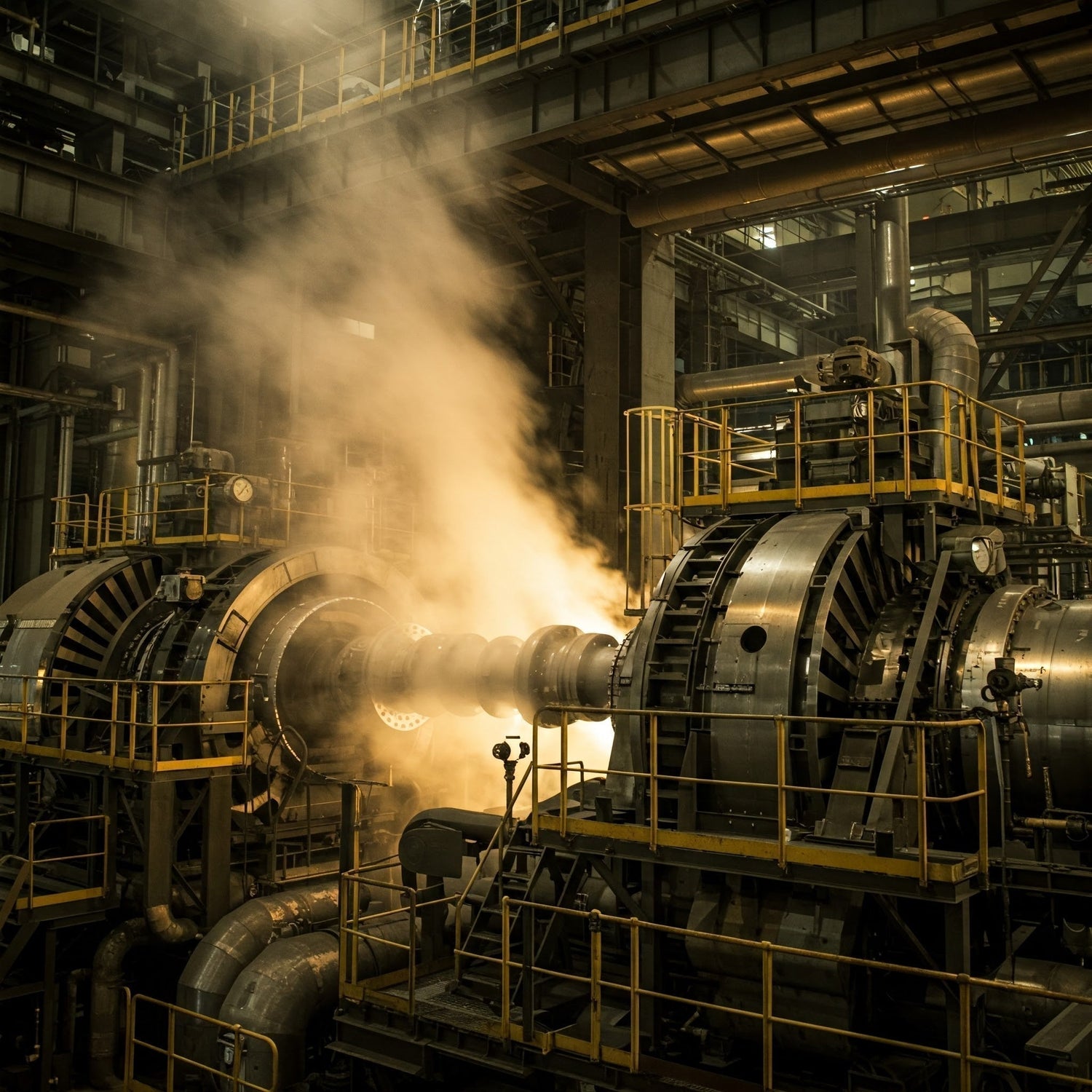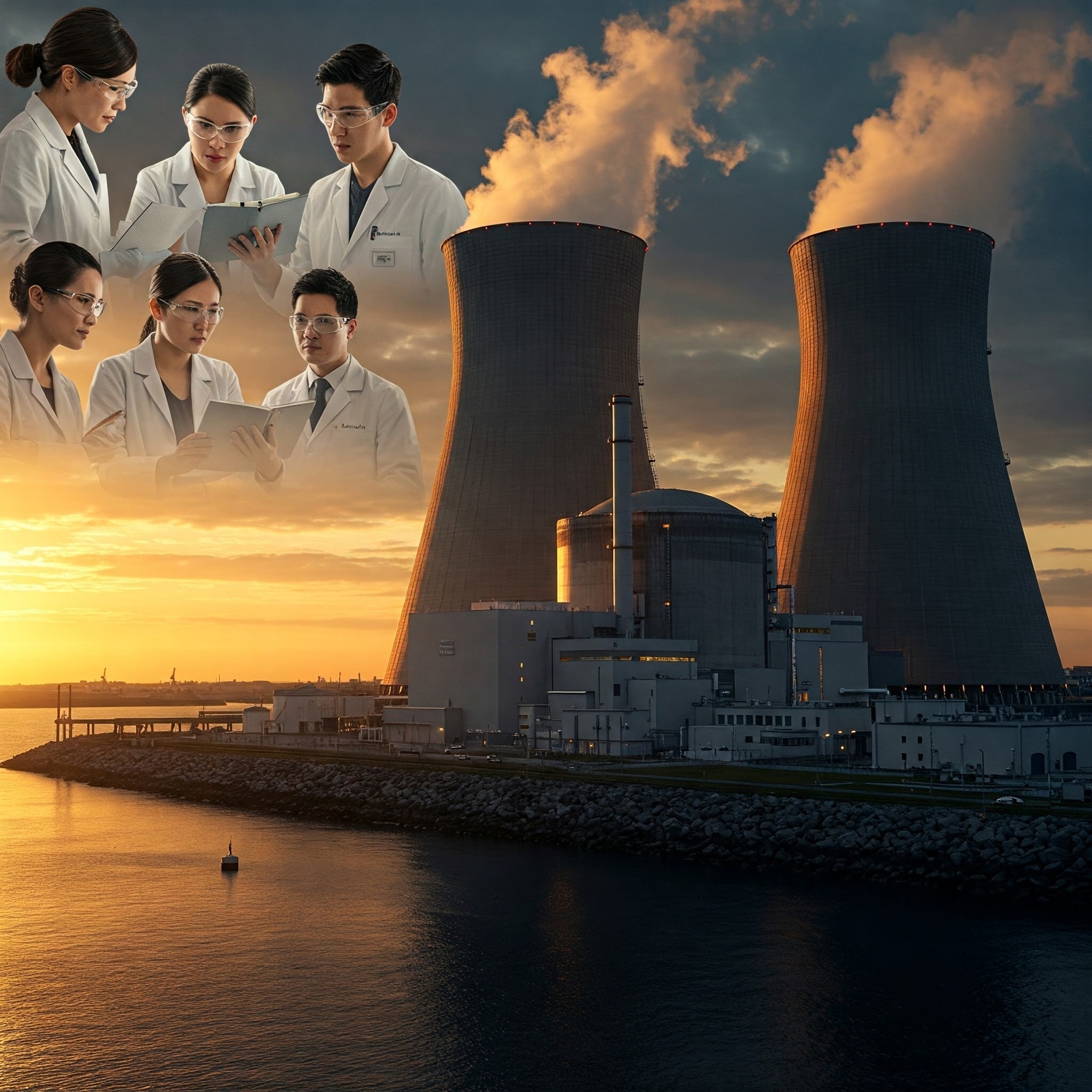Inside of a power plant, you’ll find control rooms, turbine halls, boilers, cooling towers, and fuel storage areas. This article explains how these components work together to generate electricity.
Key Takeaways
-
The control room is pivotal for monitoring plant operations, ensuring safety, and enabling real-time decision-making to maintain operational efficiency.
-
Key components of power plants, including turbine halls and boiler systems, are crucial for converting fuel into mechanical energy and generating electricity effectively.
-
Emerging technologies and renewable energy advancements are essential for the future of power plants, promoting sustainability and reducing reliance on fossil fuels.
Control Room Operations
The control room serves as the central hub for any power plant, with operators overseeing and coordinating the facility’s entire operational processes. These professionals are crucial in managing plant functions while prioritizing safety and efficiency. They utilize various communication tools, including telephones, to maintain effective collaboration among team members.
Within this command center, operators react to irregularities by making immediate decisions that promote smooth operation of the plant. Their daily responsibilities include tracking system metrics, tweaking controls to achieve optimal performance, and enacting emergency procedures to preserve safe and consistent electricity generation.
Remaining alert at all times is a critical duty for these operators. They must quickly address unforeseen incidents to ensure ongoing stability and security within the power production environment. This level of preparedness illuminates how intricately different elements interact within a power plant to facilitate energy production.
Turbine Hall

Within the turbine hall, one is immediately struck by the immense size and force of the equipment. It’s in this space that steam’s kinetic energy is transformed into mechanical energy for electricity generation. Steam turbines play a crucial role within any power plant, contributing significantly to worldwide electrical energy production.
These turbines are crafted to operate optimally under conditions of intense heat and pressure, enabling them to extract maximum energy from steam. Boilers generate this steam which propels the rotor within each turbine. Subsequently, this movement activates an attached generator that creates electricity. The methodology embodies engineering excellence by converting raw steams’ might into usable electric power efficiently.
The boilers are tasked with turning fuel into high-pressure steam, which then powers these turbines. Thanks to modern advancements yielding up to 90% efficiency rates in boilers, there is both reduced fuel usage and lowered emissions output. As such, the turbine hall serves as a pivotal nexus where energetic potential becomes vital electrical power sustaining our daily existence.
Boiler Systems
The core of steam turbine operations lies in boiler systems that heat water to generate the steam which propels turbines. The architecture of these boilers has significantly advanced, now capable of generating several thousand tons of steam every hour. This advancement mirrors the relentless quest for enhanced efficiency and performance within the realm of electricity production.
Different kinds of boilers are utilized in power plants, all uniquely tailored to optimize fuel combustion and maximize energy generation. Boilers burning solid fuels such as coal or biomass exist alongside pulverized fuel boilers, which burn finely crushed coal with high efficiency. Conversely, fluidized bed boilers augment combustion efficacy by rapidly igniting fuel particles in a medium like sand or gravel.
For optimal conversion into thermal energy during power creation, it is vital for boilers to completely combust both fixed carbon and volatile substances present in the fuel. Achieving this level ensures that a maximal degree of thermal energy is available for transformation into mechanical motion via steam turbines. Consequently, these boiler systems play an indispensable role in powering turbines essential for efficient electricity generation through their supply of pressurized steam needed throughout this process.
Cooling Towers

Cooling towers play a pivotal role in dissipating surplus heat to maintain thermal efficiency, which is vital for the process of generating power. In the absence of these towering edifices, the machinery within a power plant would be prone to overheating swiftly, potentially causing shutdowns and diminishing energy production. Cooling towers handle the additional heat arising from power generation to ensure consistent and uninterrupted operation.
The operation of cooling towers involves significant water usage to eliminate heat, which necessitates striking an equilibrium between conserving water resources and producing energy. The consumption of this water coupled with discharges from cooling towers can profoundly impact the environment by altering local ecosystems and degrading water quality. It’s imperative that these effects are regulated for sustainable functioning of power plants.
Through effective management of thermal conditions inside a plant via their design and functionality, cooling towers safeguard equipment against excessive heating thus ensuring efficient running processes at the facility. They constitute an integral component that aids in balancing productive energy generation while also attending diligently to environmental conservation concerns.
Fuel Handling and Storage
Ensuring the effective management of fuel handling and storage is vital for uninterrupted operations of power plants. In plants powered by coal, this fuel is usually kept in vast piles or silos with adequate protection against moisture to avoid combustion and maintain its quality. These storage solutions help avert spontaneous ignition and control dust release, upholding environmental safety standards.
Plants that utilize natural gas employ distinct storage techniques such as subterranean facilities, which retain gas under pressure to guarantee immediate access. This assures that the plant can swiftly tap into its fuel reserves whenever necessary, facilitating ongoing operations without interruption.
The careful handling and preservation of nuclear fuel are particularly essential due to its high energy density. This characteristic permits extensive power generation while necessitating less frequent manipulation of the material.
Overall, managing these processes efficiently is paramount for securing consistent stability and productivity in electricity generation. With a reliable supply chain for fuels like coal, natural gas or nuclear materials, power plants can operate seamlessly to generate energy effectively.
HiStand Product Integration

Incorporating sophisticated devices such as the Milerd HiStand is transforming safety procedures within power plants. This device harnesses solar energy to function autonomously, which makes it ideal for continuous radiation monitoring activities. Monitoring radiation is crucial not only for safeguarding employees, but also for adhering to health standards.
By providing instantaneous notifications and superior data recording capabilities, the HiStand amplifies existing security measures. These features play a vital role in diminishing occupational health risks and promoting a more secure work setting.
The proficiency of the HiStand in accurately tracking radiation levels marks a notable progress in upholding both the protection and integrity of operations at power plants.
Environmental Impact and Safety Measures
Strict adherence to safety protocols is crucial in energy plants to prevent accidents and manage risks effectively. During emergency situations, Control Room Operators play a pivotal role by directing team efforts toward a safe and orderly reaction. Frequent checks on electrical systems and equipment are conducted to avoid mishaps and maintain alignment with established safety regulations.
Given the presence of combustible materials within these facilities, fire prevention measures are paramount, requiring rigorous compliance with relevant procedures. Electrical safety instruction is imperative to ward off incidents involving high-voltage installations. Continuous education initiatives help foster an environment that prioritizes the welfare of both employees and surrounding residents through heightened safety consciousness.
The release of pollutants into the atmosphere from energy production sites has repercussions for air quality over expansive areas, extending well beyond their immediate surroundings. By managing such environmental effects diligently, power plants aim for sustainable operations that harmonize the demand for electricity generation with ecological stewardship responsibilities.
Energy Production and Distribution

Various methods, such as renewables and fossil fuels, are utilized by power plants for the production of energy. In nuclear power plants, solar thermal operations, and geothermal facilities, steam turbines play a crucial role in generating power. By 2025, it is expected that electricity generated from renewable sources will exceed that produced by coal-fired plants due to the expansion of renewables.
The electricity that’s been generated is then distributed through an electrical grid system which includes substations along with transformers and lines linking producers to users. To transport electric power over extensive distances, both efficiently and economically, high-voltage transmission lines are used more than lower voltage counterparts. At different stages throughout this journey, transformers regulate voltage levels ensuring delivery of electricity remains safe and dependable.
To avoid outages, balancing authorities continually work to maintain a balance between the supply of electricity available and consumer demand for it using sophisticated systems like SCADA allowing them visibility into real-time data making possible prompt responses whenever issues arise thus keeping grid operation smooth, delivering necessary electric service to residences companies alike smoothly.
In the United States, three principal interconnections comprise our national electric grid operating autonomously yet cooperatively managing supply versus demand across great expanses thereby enabling efficient transference fulfilling consumers’ needs regardless where they may be located nationwide.
Technological Innovations
The industry of power generation is continually transformed by technological progress. By utilizing the exhaust gases from combustion turbines, combined-cycle plants are able to produce supplementary electricity via steam turbines, boosting energy efficiency and cutting emissions in the process.
Enhanced communication and control over how electricity travels across networks are made possible by smart grid technologies, thereby improving both system dependability and effectiveness. Power plants have begun integrating carbon capture and storage (CCS) methods that markedly diminish CO2 levels by sequestering it below ground, a vital step toward mitigating the environmental footprint of energy production.
In terms of clean fuel substitutes, hydrogen can be generated through electrolysis processes, which also assist in maintaining sustained energy reserves for renewable sources. Meanwhile, fusion power promises an inexhaustible supply of eco-friendly energy but is still several decades away from market feasibility due to technical hurdles yet to be overcome.
Collectively these advancements signal a shift towards greater sustainability and enhanced performance within the realm of power generation.
Future of Power Plants

Renewable energy technologies such as wind and solar are revolutionizing the landscape of power generation, resulting in substantial reductions of CO2 emissions during electricity production. These advancements in clean energy innovations minimize dependence on traditional fossil fuels, facilitating a shift toward reduced emissions within the realm of power plants.
In economically developed regions, there has been a notable decline in coal usage due to an uptick in renewable sources deployment coupled with strides made towards greater efficiency. The proliferation of electric vehicles is having an impact on oil consumption patterns by signaling a move to more eco-friendly alternatives for generating power.
Confronting grid infrastructure issues involves not only establishing new transmission networks that link renewable energies with areas of high demand, but also safeguarding these systems from cyber threats. The advancement and integration of cutting-edge technologies geared towards improved energy efficiency and cleaner methods for producing electricity are vital for meeting international climate goals—this holds particularly true within developing territories.
The path forward for power stations necessitates embracing innovation while simultaneously tackling obstacles to foster an enduringly green framework for our global energy system.
Summary
Power generation facilities are intricate establishments essential to our daily existence, as they supply the electricity we rely on. Every element within these plants—from the control room to where the turbines reside—operates in unison for effective and secure power production. The adoption of cutting-edge technology and stringent safety protocols bolsters both dependability and eco-friendliness of these energy centers.
A notable innovation within power plants is the integration of devices like the Milerd HiStand, which enhances safety by providing real-time radiation monitoring. This technology not only safeguards employees but also ensures compliance with health standards, reflecting the commitment to maintaining a secure operational environment.

Looking ahead, renewable energy’s increasing prominence along with emerging technological advancements will perpetually influence the industry dedicated to generating power. Recognizing key components and obstacles associated with power plants allows us a greater appreciation for efforts toward fostering an environment marked by cleaner efficiency in terms of energy use. Power plants are embarking on an evolutionary



Leave a comment
This site is protected by hCaptcha and the hCaptcha Privacy Policy and Terms of Service apply.